Banded File Snake Acrochordus granulatus (Schneider, 1799)
Acrochordus granulatus is a non-venomous aquatic snake species commonly found throughout the waters from India, Southeast Asia, Southeast China to Solomon Islands. It is occasionally sighted at Singapore shores. It is also a popular aquatic snake in the pet trade recently.
Table of Contents
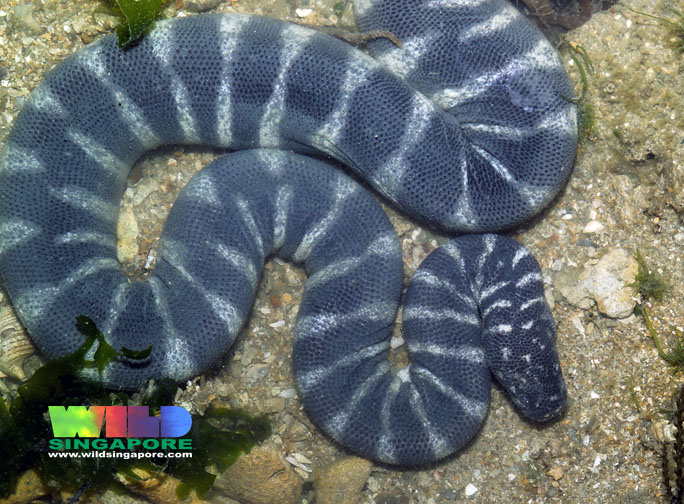 |
| Image 1: Dorsal view of a banded file snake (Acrochordus granulatus) taken in Chek Jawa. Photo Courtesy to Ria Tan and Wild Singapore. |
Name & Etymology
Scientific Name: Acrochordus granulatus
Common Names: Banded file snake, little wart snake, marine file snake, little file snake
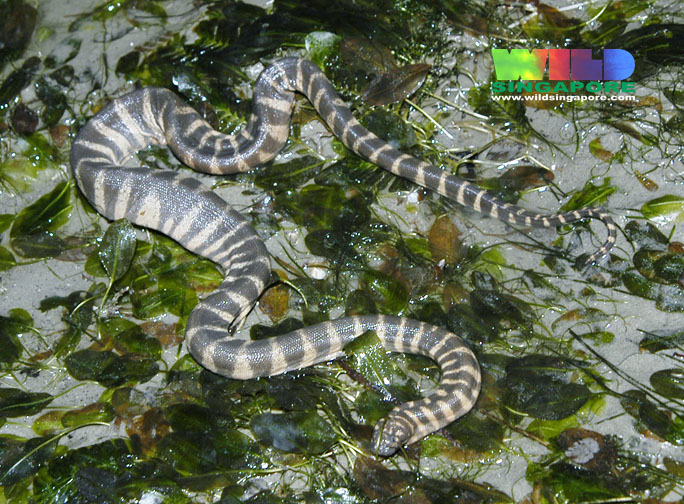 |
| Image 2: Acrochordus granulatus crawling on a shore during low tide. The loose skin on the body of A.granulatus becomes baggy once it comes out of the water. Photo courtesy of Ria Tan and Wild Singapore. |
The name of this species of snake comes from the Greek work "Acrochordon", which means "wart" in English. Whereas "granulatus" refers to the granular-shaped scales of the species. Snake species within the Genus Acrochordus are called file snakes or wart snakes due to their loose skin and rough scales, which is used to hold their prey when hunting. Acrochordus granulatus is also called the little file snake or little wart snake as it is the species with the smallest size of its Genus. Other members of the Genus Acrochordus are the Elephant Trunk Snake (Acrochordus javanicus) and the Arafura File Snake (Acrochordus arafurae).
Acrochordus granulatus was first described as Hydrus granulatus by J.G. Schneider in 1799 in his book "Historia Amphibiorum Naturalis et Literarariae Fasciculus Primus(A Natural And Literary History of Amphibious Animals Volume I)[1]. Currently other accepted synonyms for Acrochordus granulatus includes Chersydrus granulatus. A list of synonyms for Acrochordus granulatus can be found here.
Description
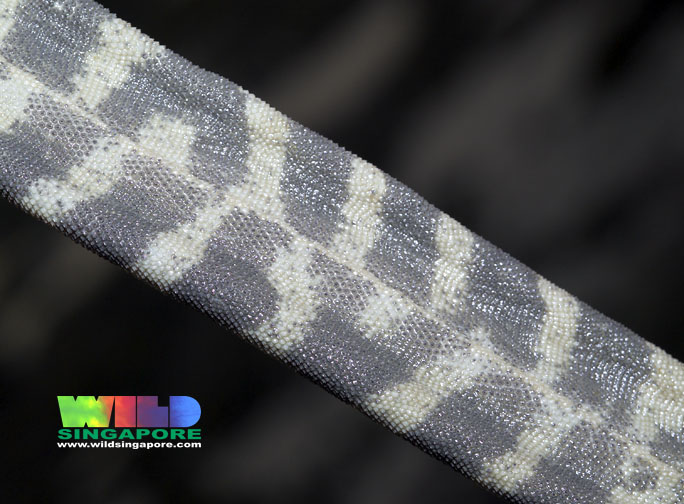 |
| Image 3: Ventral midline of Acrochordus granulatus. The ventral scutes projects down from the midline and forms a compresses keel, aiding it in swimming. Photo Courtesy of Ria Tan and Wild Singapore. |
Acrochordus granulatus, along with other members of its Genus, is completely aquatic and almost helpless on land. They are sexually dimorphic with males being much smaller with thinner and longer bodies, compared to the larger but shorter and stocky female. All species of the Genus Acrochordus are non-venomous constrictors, unlike most Asian aquatic snakes which are rear-fanged and venomous[2][3].
Members of the Genus Acrochordus are distinguished by a very loose skin and supple musculature that allow strong lateral compression and enable these snakes to seize and hold struggling fish. The ventral scutes are very small and project downward at the midline to form a compressed ventral keel during swimming. The loose skin enhances mobility beneath water but sags noticeably when a snake is out of water, hence reducing its mobility on land. The skin is prominent in being roughened by spines or tubercles that project from each of the numerous small scales covering the body. These scales enable grasping of fish and are sensory. A bundle of bristle-like structures is present in the dome of the tubercles, and the base of this structure is richly supplied with nerves. The skin between the small scales may be developed into smaller bristle-bearing tubercles. These are presumed to be sense organs that detect mechanical stimuli and aid in movement, orientation, and the capture of fish in waters where visibility can be extremely limited. Heads of the Acrochordus species are blunt and not clearly distinguishable from the neck. Valved nostrils are located at the dorsal anterior of the snout, enabling these snakes to periodically breathe atmospheric air while the remainder of the body remains underwater[2][3].
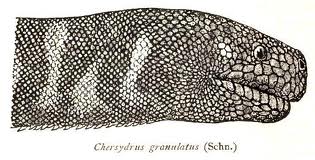 |
| Image 4: A drawing of the head of Acrochordus granulatus. The head of A.granulatus is indistinct from its neck, and the nostrils are located at the dorsal anterior (top-front) of the head, allowing it to breathe easy through the water surface. Image courtesy of Wikimedia Commons. |
Acrochordus granulatus can be easily distinguished from the Elephant Trunk Snake (Acrochordus javanicus) and the Arafura File Snake (Acrochordus arafurae) by its brownish-greyish colored skin with white or yellow stripes[3][4]. It is also smaller in size, where adults average 50–70 cm and grow to a maximum length of approximately 1 m. The other species are nearly twice this size, the Arafura File Snake reaching a maximum length of approximately 1.7 m and the Java file snake reaching a maximum length of 2 m [5].
Geographic Range & Habitat
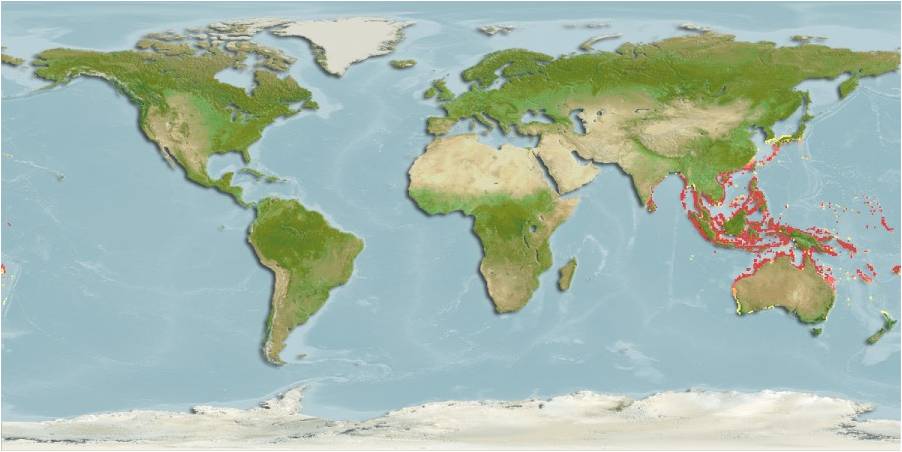 |
| Image 5: Geographic distribution range of Acrochordus granulatus. The red dots indicates presence of A. granulatus. Computer Generated Map for Acrochordus granulatus (un-reviewed). www.aquamaps.org, version of Aug. 2010. Web. Accessed 29 Oct. 2011. |
Acrochordus granulatus is found in peninsular India, Sri Lanka, Myanmar, the Nicobar and Andaman Islands, Thailand, Cambodia, Vietnam, China, the Philippines, Malaysia, Singapore, Papua New Guinea, the Solomon Islands, and the northern coast of Australia[6].
Even though there are many similarities among Acrochordus granulatus and other members in the Genus Acrochordus, they share distinct habitats. Acrochordus granulatusare mainly found in saltwater systems but are occasionally found in freshwater systems, as it can tolerate varying salinity levels. It prefers shallow coastal habitats such as mangroves and estuaries. On the other hand, the Elephant Trunk Snake (Acrochordus javanicus) and the Arafura File Snake (Acrochordus arafurae) are freshwater species, whether the former is occasionally found in estuaries but permanent occupation of marine habitats is unlikely. The Arafura File Snake (Acrochordus arafurae) is a strict freshwater species and its distribution is confined to the freshwater drainages of Papua New Guinea and those of Australia connected to the Gulf of Carpentaria and the Arafura Sea[7].
Acrochordus granulatus is occasionally found in the coastal shores of Singapore, especially in seagrass bed. It is also reported to be caught entangled in fishing nets in the reservoirs. It is speculated that there is an establish population of Acrochordus granulatus in the reservoir, which could have originated from landlocked individuals since the damming of the estuaries or migrating individuals from the sea[8].
Biology
Feeding Habits
Acrochordus granulatus appears to specialize on gobiid and goby-like fishes. Analysis of its stomach contents indicate that crustaceans may be eaten occasionally. Acrochordus granulatus hunt its prey by seizing its prey rapidly with the mouth or by swiftly ensnaring its prey in coils of the body or tail. The body is then quickly wrapped around the prey to subdue and to hold it. Even though Acrochordus granulatus are considered constrictors, the body coils function to hold and immobilize prey rather than to cause death by constricting. Captured fish are swallowed very quickly, thus little water is ingested with prey [4][9].
Acrochordus granulatus are noncturnal hunters, and have been observed to forage in shallow waters[9]. It is also reported that captive Acrochordus granulatus feed more readily and capture fish more easily in shallow than in deep water[4]. In a study by Shine & Richard (1986), the stomach contents of Acrochordus arafurae suggests that snakes in the Genus Acrochordus feeds less frequently in contrast with other aquatic snake and is considered to be a low energy specialist[10].
Interestingly, the feeding habits differs between male and female Acrochordus granulatus. Female individuals which have a larger and slightly stocky body, hunts by ambushing its prey. On the other hand, the male Acrochordus granulatus hunts by actively foraging[11].
Natural Predators
Natural predators of Acrochordus granulatus includes crocodiles, sea eagles, and humans[7].
During daytime, Acrochordus granulatus hides among tangled mangrove roots, river edges, or in holes and burrows. In captivity, these snakes bury themselves in mud, or coil themselves under artificial rock crevasses. They are occasionally seen swimming to the surface to breathe. Acrochordus granulatusare adept swimmers, their loose and baggy skin allows them to flatten it to move gracefully underwater. However, it is observed to crawl sluggishly over muddy substrates at the bottom of streams or swamps most of the time[7].
There is currently no known function of the banded patterns on the body of Acrochordus granulatus. However, it is sometimes mistaken as the highly venomous Yellow-lipped Sea Snake (Laticauda colubrina). Click here to know how to tell apart Acrochordus granulatus with the Yellow-lipped Sea Snake (Laticauda colubrina).
Reproduction
All three species of the Genus Acrochordus appear to have seasonal reproductive cycles, even though they are active year-round in tropical habitats. These snakes are viviparous, and their young are born alive. Gestation begins in the middle of the year, and birth usually occurs in December. Evidence suggests that female Acrochordus granulatus do not give birth every year, with its reproductive frequency around once every two years. The litter size of Acrochordus granulatus averages around 5 offsprings. No parental care is observed for captive Acrochordus granulatus. Females are also able to delay conception and hold sperm until suitable birth conditions are met [9][12].
Conservation
According to The IUCN Red List of Threatened Species, the red list category & criteria of Acrochordus granulatus is listed as least concerned [6]. However, increasing demands in the pet trade industry as well as other threats might threaten populations of Acrochordus granulatus is certain areas. However, the pet trade of Acrochordus granulatus is uncommon in Singapore.
In the Philipines, Acrochordus granulatus is hunted for its skin, where it is used as leather and to make drums. Even though there are strict regulations prohibiting the hunt and trade of the products, low levels of enforcement are resulting in illegal catches of Acrochordus granulatus. Another threat to these snakes are by-catches of trawling[5]. Other potential threats to Acrochordus granulatusare related to physical disturbances of rivers, estuaries, and wetlands and to various forms of water pollution. However, the effect of such factors on the distribution and abundance of Acrochordus granulatus is almost totally unknown and is in need of evaluation.
Taxonavigation
Kingdom: Animalia
Phylum: Chordata
Subphylum: Vertebrata
Class: Reptilia
Order: Squamata
Suborder: Serpentes
Family: Acrochordidae
Genus: Acrochordus
Species: Acrochordus granulatus
Currently there is only one Genus under the Family Acrochordidae, with three extant species, namely the Banded File Snake (Acrochordus granulatus), the Elephant Trunk Snake (Acrochordus javanicus), and the Arafura File Snake (Acrochordus arafurae). A fourth extinct species in the Genus Acrochordusis known that existed in the Upper Miocene and Lower Pliocene epochs of Pakistan. There are currently no Acrochordus granulatus subspecies recognized[3].
According to McDowell (1979), the phylogenetic relationships between acrochordids and other snakes are unclear. The snakes in this family retain some primitive characteristics but have evolved numerous specialized traits. Some morphologic features are so different from those of other snakes that file snakes have been joined in a separate superfamily, the Acrochordoidea. They appear to be related most closely to advanced snakes: colubrids (a large family including many common and familiar snakes such as garter snakes, rat snakes, and king snakes), elapids (cobras and their relatives), viperids (vipers and pit vipers), and a group of African snakes known as Atractaspididae[3].
Type Information
The type information here illustrates the name-bearing type (under the International Code of Zoological Nomenclature, the biological type that determines the application of the particular taxon's name) and the type locality, which is the geographic location of where the particular specimen is found. A holotype, in this case, is a particular specimen which is used to formally describe that species. In most of the case, the holotype is then preserved under strict conditions in a museum. However, the type information for Acrochordus granulatus is currently unknown.
Types (Holotype): Unknown (fide Sang et al., 2009)
Type Locality: Not given (fide Manthey & Grossmann, 1997); “Madras, India” (fide Sang et al., 2009)
References
[1] Schneider, J. G. 1799. Historiae Amphibiorum narturalis et literariae. Fasciculus primus, continens Ranas. Calamitas, Bufones, Salamandras et Hydros. Jena, 266 S.
[2] McDiarmid, R.W., Campbell, J.A., Touré, T. 1999. Snake Species of the World: A Taxonomic and Geographic Reference, vol. 1. Herpetologists' League. 511 pp.
[3] McDowell, S. B. 1979. A Catalogue of the Snakes of New Guinea and the Solomons, with Special Reference to Those in the Bernice P. Bishop Museum: Part III, Boinae and Acrochordoidea (Reptilia, Serpentes). Journal of Herpetology, 13, 1–92.
[4] Lillywhite, Harvey B. 1996. Husbandry of the Little File Snake, Acrochordus granulatus. Zoo Biology, 15, 315–327.
[5] Lillywhite, Harvey B. 1991. The Biology and Conservation of Acrochordid Snakes. Hamadryad, 16, 1–9.
[6] Sanders, K., Murphy, J., Lobo, A. & Gatus, J. 2010. Acrochordus granulatus. In: IUCN 2011. IUCN Red List of Threatened Species. Version 2011.2. <www.iucnredlist.org>. Retrieved 29 October 2011
[7] Lillywhite, Harvey B., Ellis, M.T. 1994. Ecophysiological Aspects of the Coastal-Estuarine Distribution of Acrochordid Snakes. Estuaries, 17, 53–61.
[8] Ng, T.H. 2011. A record of the banded file snake, Acrochordus granulatus (Reptilia: Squamata: Acrochordidae) in a freshwater habitat in Singapore. Nature in Singapore, 4, 91-93.
[9] Voris, Harold K., Glodek, G.S. 1980. Habitat, Diet and Reproduction of the File Snake,Acrochordus granulatus, in the Straits of Malacca. Journal of Herpetology, 14, 105–108.
[10] Shine, Richard. 1986. Ecology of a Low-Energy Specialist: Food Habits and Reproductive Biology of the Arafura Filesnake (Acrochordidae). Copeia, 424–437.
[11] Shine, R. 1991. Intersexual Dietary Divergence And The Evolution of Sexual Dimorphism In Snakes. The American Journalist, 138, 103-122.
[12] Houston, D., Shine, R. 1994. Movements And Activity Patterns of Arafura File Snakes (Serpentes: Acrochordidae) In Tropical Australia. Herpetologica, 50, 349-357.
Additional Comments
You can contribute to this article by leaving any comments or additional information regarding Acrochordus granulatus. You can do so but clicking the "Discussion" Tab at the top of the page and post a new comments. The top 20 recent comments will be shown below:
| Subject | Author | Replies | Views | Last Message |
|---|---|---|---|---|
| No Comments | ||||